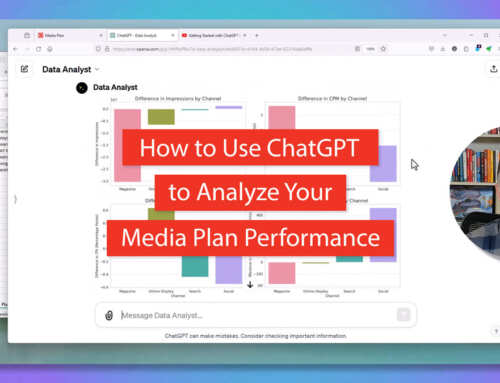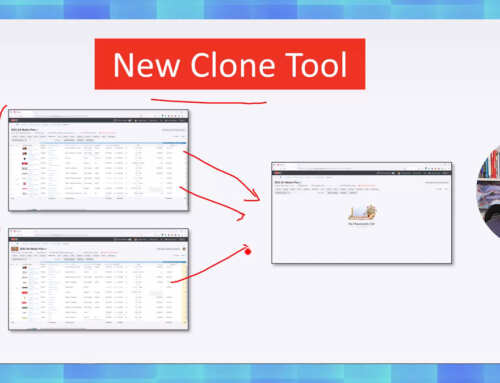Calculating the cost of media can be tricky. If you’ve ever been tasked with doing the math on media plans, media authorizations, insertion orders, or invoices, you can attest to this. You practically have to be a genius to get everything right on a complex media plan. It’s almost impossible to avoid embarrassing mistakes.
Media calculations can sometimes get insanely complicated.
Some vendors quote prices using net rates and others quote prices using gross rates. There are a variety of ways to calculate the cost of a line item contingent on the cost method, which could be cost per thousand (CPM), dynamic CPM, viewable CPM, cost per click (CPC), cost per action (CPA), gross rating points (GRP), target rating points (TRP), share of voice, per month, per week, per day, flat rate, makegood, value add, or some other method. To make line item pricing more complicated, vendors often bundle a bunch of line items together and price it as a package. It gets even more convoluted when every vendor wants to get paid in their local currency, your advertiser wants to see all the amounts translated into their base currency, and your CFO wants to see it all in your home currency.
Calculating your agency’s compensation on a campaign can also get complicated. Each of your clients has a different way of paying you – commission on gross media cost, commission on net media cost, different commission rates, hourly fees, fee per campaign, fee per line, flat fee per month, performance-based compensation, or some combination of the above. It’s important to get this exactly right because you don’t want to get busted for over-charging and you don’t want to leave money on the table.
The reason these calculations are so difficult and error-prone is because they are often done in pieces with Microsoft Excel and other systems that weren’t exactly designed to handle all the complexity inherent in these media calculations. As a result, you spend long hours manually running the numbers, double-checking your calculations, and keeping all your systems in sync. If you’re new on the job or learning these calculations on the fly while serving your client, solving all these math equations is a stressful “baptism by fire.”
Good news: with Bionic’s media planning software, you now have an easy way to confidently calculate and to master all these tricky media equations.
The team at Bionic Advertising Systems has spent the last few months researching media formulas, poring over accounting standards, and interrogating media experts to develop and codify forty-seven media-specific calculations. “We stopped just short of waterboarding to extract all the information we needed to develop these formulas,” said Joseph Pych, Co-Founder and CEO of Bionic. “This project was much harder than we expected because no one person at an agency knew it all. Some parts were in the heads of people in the media department, other parts were in the heads of management, and other parts were in the heads of finance people. Plus, we discovered a bunch of discrepancies between different agencies.”
The result of this project is a comprehensive set of accurate and reliable media calculations that can be used in the most challenging situations. With its compliance with FASB and ISA accounting guidelines, it will satisfy even the most demanding financial auditors.
All of this intelligence is baked into the July 2014 release of Bionic Media Planner (version 2.10). Every line item on your media plan now includes an option to examine and adjust the costing details, which is represented as a thirty line worksheet broken into four sections: Net Media Cost, Agency Compensation, Ad Serving fee, and Total Media Cost. It enables you to quickly and confidently calculate and verify every element on every line of your media plan.
As you would expect, Bionic Planner handles both gross and net pricing:
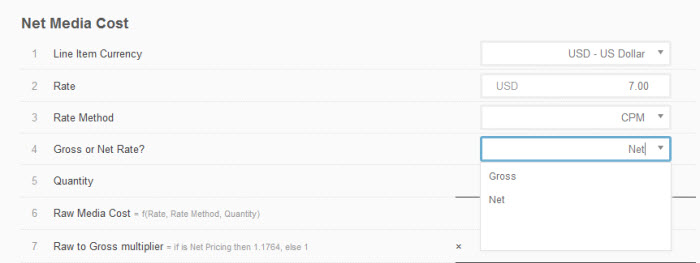
Bionic Planner also handles all the rate methods you expect:

Bionic Planner goes above and beyond in the way it handles multiple currencies and exchanges:
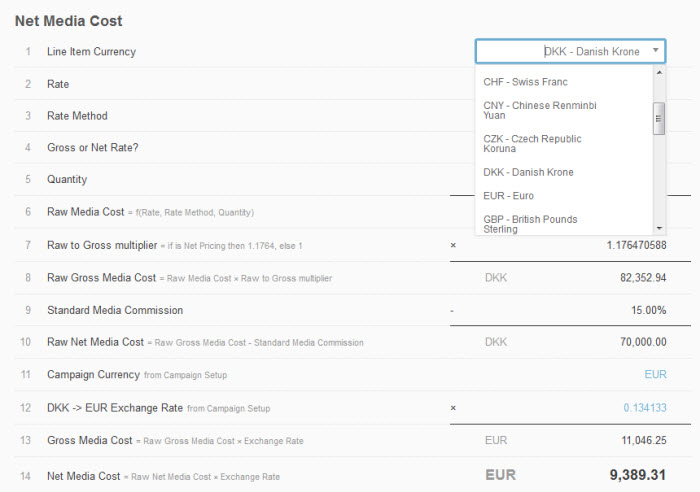
For example, suppose you’re at a New York-based agency working for a London-based advertiser who is advertising throughout Europe. The advertiser wants to see the media plan expressed in British pounds. However, the publishers on the plan price their products in Euros, Swiss francs, Danish Krone, and Polish Zloty (and expect to get paid that way). Furthermore, your CFO wants to see this all translated into US dollars. You have to follow strict accounting rules – namely FASB 52 and IAS 21 – to do all these currency exchanges properly to avoid getting into financial trouble.
Bionic Planner automatically handles multiple currencies and exchanges between Australian Dollar, Brazilian Real, Canadian Dollar, Chinese Renminbi Yuan, Czech Republic Koruna, Danish Krone, Euro, British Pounds Sterling, Hong Kong Dollar, Hungarian Forint, Indian Rupee, Japanese Yen, Mexican Peso, Norwegian Krone, New Zealand Dollar, Polish Zloty, Romanian Leu, Russian Ruble, Swedish Krona, Swiss Franc, Singapore Dollar, South African Rand, Turkish Lire, US Dollar, and many more.
Bionic planner also automatically handles complicated agency fee calculations and opens up possibilities for new agency compensation models:

Best of all, you see all these calculations presented in an easy-to-follow, step-by-step instructional worksheet. Besides making it easy to validate, it’s an excellent learning tool.
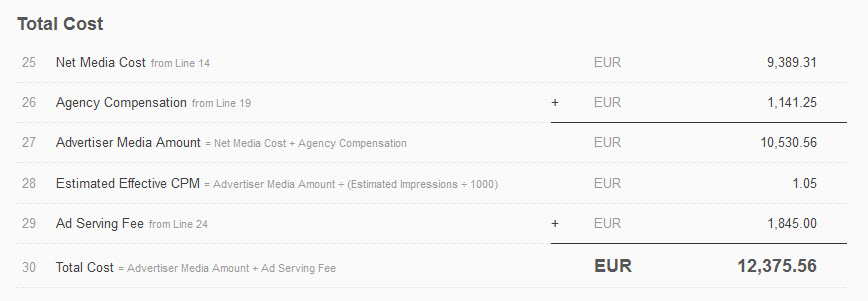
With Bionic Planner, you no longer have to hold a PhD in media finance to confidently calculate every element of your campaign to perfection. This new functionality is available today. To access the worksheet calculations, open up your media plan and click the “View Details” option on any line item action button or click on one of the cost numbers.

If you’re not already using Bionic Planner, request access today at: https://bionic-ads.com/planner/.


